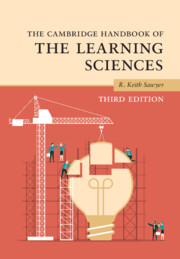Book contents
- The Cambridge Handbook of the Learning Sciences
- The Cambridge Handbook of the Learning Sciences
- Copyright page
- Contents
- Figures
- Tables
- Contributors
- Preface
- 1 An Introduction to the Learning Sciences
- Part I Foundations
- Part II Methodologies
- Part III Grounding Technology in the Learning Sciences
- Part IV Learning Together
- Part V Learning Disciplinary Knowledge
- Part VI Moving Learning Sciences Research into the Classroom
- 29 Learning as a Cultural Process
- 30 Designing for Meaningful Learning
- 31 Advances in Teacher Learning Research in the Learning Sciences
- 32 Learning Sciences and Policy
- 33 The Learning Sciences in the 2020s: Implications for Schools and Beyond
- Index
- References
33 - The Learning Sciences in the 2020s: Implications for Schools and Beyond
from Part VI - Moving Learning Sciences Research into the Classroom
Published online by Cambridge University Press: 14 March 2022
- The Cambridge Handbook of the Learning Sciences
- The Cambridge Handbook of the Learning Sciences
- Copyright page
- Contents
- Figures
- Tables
- Contributors
- Preface
- 1 An Introduction to the Learning Sciences
- Part I Foundations
- Part II Methodologies
- Part III Grounding Technology in the Learning Sciences
- Part IV Learning Together
- Part V Learning Disciplinary Knowledge
- Part VI Moving Learning Sciences Research into the Classroom
- 29 Learning as a Cultural Process
- 30 Designing for Meaningful Learning
- 31 Advances in Teacher Learning Research in the Learning Sciences
- 32 Learning Sciences and Policy
- 33 The Learning Sciences in the 2020s: Implications for Schools and Beyond
- Index
- References
Summary
This chapter reviews the implications of learning sciences (LS) research for schools, including assessment, curriculum, teaching practice, and systemic transformation. A central theme of this review is the role of technology in education – its history, its failings and successes, and how future technology designs can be grounded in LS. The chapter then describes some trends and opportunities in the field of LS research, including the integration of individual and sociocultural research approaches; the ways that LS research can contribute to equity and diversity in learning and in schools; and the sociology and history of LS as a discipline.
Keywords
Information
- Type
- Chapter
- Information
- The Cambridge Handbook of the Learning Sciences , pp. 658 - 686Publisher: Cambridge University PressPrint publication year: 2022
References
Accessibility standard: Unknown
Why this information is here
This section outlines the accessibility features of this content - including support for screen readers, full keyboard navigation and high-contrast display options. This may not be relevant for you.Accessibility Information
- 3
- Cited by
